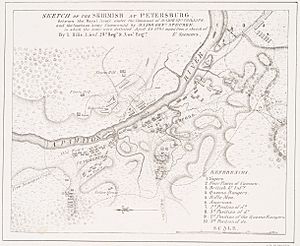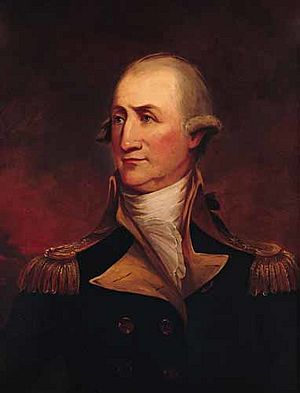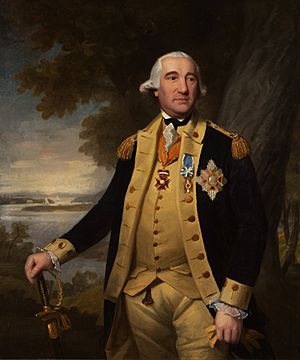Battle of Blandford facts for kids
Quick facts for kids Battle of Blandford (Petersburg) |
|||||||
|---|---|---|---|---|---|---|---|
| Part of the American War of Independence | |||||||
 A British engineer's sketch of the battle |
|||||||
|
|||||||
| Belligerents | |||||||
| Commanders and leaders | |||||||
| Baron von Steuben Peter Muhlenberg |
William Phillips Benedict Arnold |
||||||
| Strength | |||||||
| 1,000 | 2,500 | ||||||
| Casualties and losses | |||||||
| over 150 | 25–30 | ||||||
The Battle of Blandford, also known as the Battle of Petersburg, happened on April 25, 1781. It was fought near Petersburg, Virginia, during the later part of the American War of Independence. In this battle, about 2,300 British soldiers, led by Brigadier General William Phillips, defeated around 1,000 American militia. The American forces were commanded by Major General Baron von Steuben.
Earlier in 1781, a British force, including soldiers led by Benedict Arnold (who had switched sides from the Americans to the British), arrived in Virginia. This made the local American militia more active. However, the militia were not very well trained or equipped. They couldn't stop Arnold from moving around freely. In March 1781, General Phillips brought more troops to help Arnold. They planned to attack Petersburg.
American militia leaders, von Steuben and Peter Muhlenberg, decided to make a stand at Blandford. Blandford was a separate town back then, but it's now part of Petersburg. Even though they were outnumbered, the American militia fought bravely. They then made an organized retreat across the Appomattox River. This helped them avoid being surrounded by British forces led by John Graves Simcoe. The Americans eventually retreated to Richmond. There, they joined forces with Continental Army troops led by the Marquis de Lafayette. Phillips and Arnold continued their attacks and later joined up with Charles Cornwallis's army from North Carolina.
Contents
Why the Battle Happened
By late 1780, the American Revolutionary War was at a tough point. The American Continental Army had lost many battles. Money was losing its value, and people were getting tired of the war. Soldiers were also unhappy with their pay and conditions. However, the British had also suffered a big defeat at Kings Mountain in October.
To help the American cause in the south, General George Washington sent Major General Nathanael Greene. Greene was one of his best leaders. His job was to rebuild the American army in North Carolina. Meanwhile, Charles Cornwallis, who led the British troops in the south, wanted to defeat Greene and take control of North Carolina.
Arnold's Arrival in Virginia
Cornwallis asked General Sir Henry Clinton to send troops to Virginia. This would make the Americans focus on Virginia instead of North Carolina. So, in December 1780, General Clinton sent Brigadier General Benedict Arnold to Virginia. Arnold had switched sides from the Americans to the British in September. He brought 1,600 men with him.
Arnold's orders were to destroy American supplies in Virginia. Virginia had mostly avoided fighting before 1780. Arnold also had to set up a base at Portsmouth. On January 4, Arnold sailed up the James River and landed his troops. The next day, he quickly attacked Richmond, the state capital. After two days of attacks, he returned to his boats and sailed to Portsmouth. He then started building defenses there.
General Washington wanted to stop Arnold. He sent the Marquis de Lafayette with American troops to Virginia in February. Washington also asked the French admiral, Charles René Dominique Sochet, Chevalier Destouches, to send French ships and soldiers to help Lafayette.
After some naval battles, British ships carrying 2,000 soldiers arrived. These troops were led by General William Phillips. Phillips and his troops landed at Portsmouth on March 26. Since Phillips was a higher-ranking officer than Arnold, he took command of all the British forces there.
Phillips's Attacks
General Phillips then started attacking the Virginia countryside. Major General Baron von Steuben tried to stop them and protect Richmond and Petersburg. Von Steuben knew that Petersburg was a very important target for the British. It was a major storage place for American military supplies.
By April 23, the British force had sailed up the James River. They landed and drove off about 500 American militia. Reports told von Steuben that the British force was between 2,500 and 3,000 men strong.
On April 24, about 1,000 Virginia militia, led by General Muhlenberg, marched into Petersburg. Other militia units were also gathering. Lafayette's troops were still days away, and another American force was even further off. Von Steuben and Muhlenberg had been avoiding direct fights with the British because their troops were few and inexperienced. But they decided it was time to make a stand. The militia's spirits were low because they hadn't won any battles since the British arrived.
After a meeting, they decided to set up a defense line in Blandford. This was a separate town east of Petersburg. The plan was that if they had to retreat, they would cross the Appomattox River over the Pocahontas Bridge. That evening, von Steuben ordered Muhlenberg's troops to the north side of the Appomattox River. Then, during the night, von Steuben and Muhlenberg moved their main forces south of the river into Blandford.
The Battle Begins

Just before sunset on April 24, Phillips landed 2,500 British and Hessian soldiers at City Point (now Hopewell). This was about 12 miles (19 km) east of Petersburg. The next morning, four regiments of Muhlenberg's Virginia militia formed two lines of defense. They waited for the British.
The first line was near the river on the left and extended into the hills on the right. The second line was meant to be the main defense after the first one fell back. This line was along what is now Madison Street in Petersburg. It was set up to make sure the British troops would be exposed to American gunfire as they approached. Von Steuben also placed one regiment on the north side of the Appomattox River. This was to guard against the British landing there. He also had a small group of soldiers at the Pocahontas Bridge.
The British started marching around 10 AM, heading toward Petersburg. Phillips's force included several British regiments, John Graves Simcoe's Loyalist Queen's Rangers, Arnold's American Legion, and Hessian jägers. Phillips had planned to go after military supplies elsewhere, but he learned the Americans had already moved them. So, he marched directly to Petersburg. Eleven small gunboats went with the British force up the Appomattox River.
The battle started with an exchange of fire between the British gunboats and American scouts. Around 2:00 PM, Phillips stopped his troops about one mile (1.6 km) from the American lines. He then got his forces ready for battle.
As the British advanced, Phillips and his officers noticed some American militia on a hill. They had a good position to fire along the British line. The British sent their jägers to remove them. The fighting then became general. The first line of American militia fought harder than the British expected. But the British artillery and their larger numbers eventually forced the first militia line to retreat to the second line after about 30 minutes.
Phillips also sent Simcoe and his rangers on a long flanking move. This was meant to stop the Americans from retreating across the Pocahontas Bridge. While Simcoe moved, Phillips attacked the second American militia line twice, but both attacks were pushed back. It wasn't until the British artillery was in a better position to fire on the American line, more than an hour later, that von Steuben finally ordered a retreat.
The Americans were able to retreat in an orderly way across the bridge. Soldiers on the high ground on the other side of the bridge covered their retreat. The last companies to cross the bridge removed its wooden planks as they went. This delayed the British pursuit. This action was later praised by important figures like Thomas Jefferson and General Nathanael Greene.

The Americans paused on the heights near Violet Bank (in Colonial Heights today). They exchanged artillery fire with the British on the opposite bank, causing more losses on both sides. After getting some rum, the tired militia continued their retreat north. They reached Chesterfield Courthouse the next day. The British force crossed the Appomattox River soon after, destroying three more bridges behind them.
What Happened Next
Phillips and Arnold continued to chase the retreating American militia to Manchester, which was across the river from Richmond. They reached Manchester on April 29. However, they couldn't enter Richmond because Lafayette had marched quickly and already occupied the city. After destroying tobacco warehouses in Chesterfield County, the British sailed back down the James River to Westover. Lafayette advanced as far as Pocahontas.
At Westover on May 7, Phillips received orders to return to Petersburg and wait for Lord Cornwallis. Cornwallis was moving north from Wilmington, North Carolina. When Phillips reached Petersburg on May 9, Lafayette's artillery, positioned north of the river, began firing on them. General Phillips became sick with typhoid fever and died on May 13. This left Arnold temporarily in command of the British force.
Cornwallis reached Petersburg on May 20, bringing the British force to 5,300 men. Soon after, more British soldiers arrived from New York, increasing his force to over 7,000 men. Cornwallis sent Arnold back to New York. He then chased Lafayette for a while through central Virginia before returning to Williamsburg.
Cornwallis was eventually ordered to build defenses at Yorktown. There, Lafayette, joined by a French force, blocked the land routes. The French fleet stopped British relief ships from arriving. With the arrival of George Washington and the American and French army, Cornwallis was surrounded. He surrendered his army on October 17, 1781.
Petersburg was again a center of military activity during the American Civil War. It was besieged for nine months in 1864 and 1865. The role of Petersburg in this later conflict is often remembered more. However, since 1992, the city of Petersburg has held an annual reenactment of the Battle of Blandford.
Images for kids



